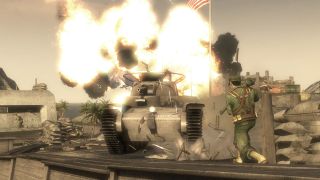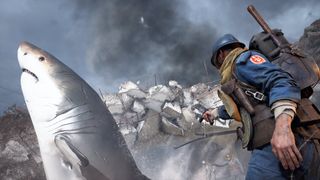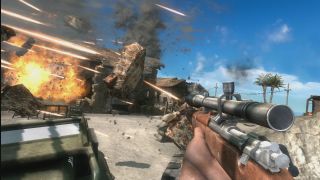As Battlefield 1943 shuts down, DICE looks back on its scrappy, console-exclusive classic
Interview | "It was a true halcyon project"

Bitesize is not a word you'd naturally ascribe to Battlefield. DICE's first-person shooter series tends to paint its theaters of conflict with brushes the size of garden brooms, delivering vast, operatic sandboxes, thunderous soundscapes, and player counts big enough to fill out a Boeing 737. From Friday, April 28, Battlefield 1943 will be removed from all digital storefronts after over a decade of service (alongside both Bad Company games), and yet bitesize is nevertheless the adjective that comes to mind for Patrick Liu when recalling the development of DICE's unexpected spin-off to series progenitor Battlefield 1942.
"We talked a lot about a bite-sized Battlefield for 1943," explains Liu, who served as Lead Producer on the game. "It was quite a controversial idea, given Battlefield's history, but we wanted to make something smaller and leaner for that time."
That time that Liu's referring to is, as it happens, the key context that helps explain why DICE's decision to scale down its next Battlefield game made perfect sense. The studio began working on Battlefield 1943 in 2008, just a few years into the launch of the seventh-generation consoles, and their subsequent push towards fully integrated online entertainment. The surging popularity of the digital storefronts found across PS3, Xbox 360, and the Nintendo Wii were illustrating a healthy demand for smaller, cheaper titles exclusive to the online marketplace, with Xbox launching its Summer of Arcade that very year, headlining runaway hits such as Braid, Castle Crashers, and Bionic Commando: Rearmed.
DICE wasn't just reading the industry tea leaves, however. Internal conditions at the studio also made the winds favorable towards the development of a tighter, more experimental Battlefield, as Lead Development Director Robert Wasser explains.
"DICE had been working on Battlefield 3 for many years, and that project had been restarted several times. At that time, the Battlefield 3 team was rebooting, and many people in the studio were in ideation, so not really assigned to a project that was shipping. The studio had recently shipped Bad Company 1, so we had a stable version of our game engine Frostbite for Xbox 360 and PS3 that could quickly be put to use."
Roll of the dice


The 10 best Battlefield games of all-time
According to Liu, the first conceptual pitch for the project centered around a "best of Battlefield"-type experience, featuring greatest hits from across the series' history, but that quickly proved too ambitious for the game's tight development timeline. The team then landed on the idea of offering a distinct set of multiplayer experiences from each theater of conflict across World War 2, "one from Europe, one from the Pacific, and so on," but, again, pipeline constraints put a halt to that plan.
The concept of a Pacific-set shooter kept coming up, however, and it wasn't long before that backdrop became the singular focus for the project. This would, of course, turn out to be a very smart move, with Battlefield 1943's sun-kissed environments and brighter color palette offering a warm counterbalance to the murky, ashen aesthetics of its contemporaries Working under the codename "Beach", development for Battlefield 1943 was to be as lean and lightweight as its scope, with a small team aiming to ship the game within the space of a year. For Audio Director Ben Minto, this meant holding sole responsibility for the development of "almost all of the sound design, implementation, music direction, voice over and mix".
Sign up to the GamesRadar+ Newsletter
Weekly digests, tales from the communities you love, and more
"I joined DICE originally to work on Mirror’s Edge, where audio followed art style; clean, pure, simple yet stylized – really refined," says Minto. "This was almost the opposite of the gritty, raw and grounded aesthetic found on Battlefield Bad Company, which openly embraced dirt, errors, and chaos as part of its audio direction. For 1943, I took a bit of each flavor to find a coherent 'new'. The weapons sound like Mirror’s Edge weapons close up, but with even more tape saturation; over distance, they take on the harsh realism of Bad Company."
Players would be hearing no shortage of gunfire in Battlefield 1943, too, thanks to some key tweaks made to the existing franchise design mold in an effort to, according to Liu, "make a more accessible Battlefield experience".
He continues: "From a creative standpoint, there were a lot of things that we did that were very controversial at the time. One example is that we had infinite ammo. We wanted to get rid of the need to go back to base somewhere and replenish your ammo, but also wanted to maintain the tactical aspect of taking cover and reloading before going back into combat."
"So we landed on having an infinite number of clips, but you still needed to reload when the clip was empty. In the same fashion, we had an infinite number of grenades, but with a cooldown in between use, to ensure there was still some restraint."

"The team size was small and close, so small, in fact, that we were under the radar and just got on with things with little to no external pressure".
These weren't the only drastic shakeups, either. Previous Battlefield titles offered a set of infantry classes that typically numbered anywhere between the four to six range, but 1943 brought that total down to a streamlined three: the Infantryman, Rifleman, and Scout. Matching that rule of three was the map count, each one representing a Pacific island actively contested by the game's two warring factions; the Japanese and US armies.
"As budgets were tight we handled all the voiceover in-house," says Minto, recalling the development of the Japanese and American class characters. "We found great local talent in Shep Gest, Thomas Hogan, and Jun Yamazaki. Shep has a deep, warm, resonant voice, which was fitting for the confident US veteran heard during training, whilst Thomas’s voice had the younger, nervous rookie tone we wanted. It was a bit all over the place, uncontrolled, with lots of movement and emotion, which was great when contrasted with Jun’s brutally efficient delivery for the Japanese soldiers. Jun was a Kendo champion, so his performance was very controlled; almost a square wave, like a punch to the face or the hits of the taiko drumming in the game's Japanese theme."
With classes thus presented more as distinct characters for 1943, bespoke weapon customisation was taken off the table. Players still had plenty of agency to express their combat style, however, thanks to the abundance of planes, jeeps, tanks, and anti-air guns scattered across each map, not to mention air raid bases that offered the ability to launch a devastating bombing run on key capture points around the islands. Throw in an improved destruction system via the Frostbite engine, and the total sum of 1943's parts resulted in an experience that retained Battlefield's reputation for taught, squad-based tactical warfare, but now endowed with a more playful spirit and purer structure that made it an easier sell for longtime fans to recruit their friends into the fold.
Beach party

When Battlefield 1943 launched on the PSN Store and Xbox Live Arcade in July 2009, it wasn't long before it started to break records, becoming the fastest-selling digital game of all time within the first 24 hours of release. It was so popular, in fact, that DICE struggled to keep players online, in what could now be seen as a portending microcosm of the server troubles that the studio would run into with almost every subsequent Battlefield launch.
"We quickly had to work on our backend infrastructure and get enough server capacity in place in those first few weeks," says Wasser. "I remember us borrowing server space from other parts of EA, just to make sure we could accommodate all the players that wanted to join!"
Even to this day, it's not difficult to find a populated match on console, especially Xbox platforms, where 1943 has found a new lease of life thanks to its inclusion on Game Pass. That changes this week, however, as EA delists Battlefield 1943 (alongside both Bad Company games) as part of plans to retire the game's online servers later this year, essentially rendering it unplayable in its existing form. For Liu, EA's decision isn't an easy one to swallow, but recognises why the call was made.
"It's sad, of course, that no one will ever be able to play that game again. It's a bit of history that's being lost. But I understand from a technical and commercial standpoint that it doesn't make sense to run it anymore. Some games have been open-sourced in the past, so that the community can run their own servers, and if that could be another option for EA in the future, that would be nice to see. But, if not, it had a good run, and I'm just happy that I was part of that."

Wasser is equally bittersweet, cherishing the memories of 1943's scrappy, guerilla development: "We were a bit of the underdogs of the studio at the time, as the focus was on Battlefield: Bad Company 2 and Battlefield 3. But, thanks to our small team size and stable tech, we were able to iterate and try new things quicker and more nimble than the large teams, so some of our learnings and innovations ended up in the larger games."
"It was a true halcyon project," Minto concurs. "The team size was small and close, so small, in fact, that we were under the radar and just got on with things with little to no external pressure. I think it was a surprise to the upper echelons when, within a few months, we showed something that was almost finished, and offered pure, Battlefield fun to play. The development was as close to perfect as I have ever experienced."
Battlefield 1943 may be lost to the realities of EA's fiscal strategy, then, but the learnings and iterations that DICE were able to take from its creation will continue to live on well into the series' future. Indeed, after the overly somber, bloated leviathan that was Battlefield 2042, DICE could perhaps benefit from taking another re-examination of the cleanest, lightest entry in its back catalog to date, and rediscover the notes that made 1943 truly sing.
Lock and load with the best FPS games out now
I'm GamesRadar's Features Writer, which makes me responsible for gracing the internet with as many of my words as possible, including reviews, previews, interviews, and more. Lucky internet!
Most Popular






